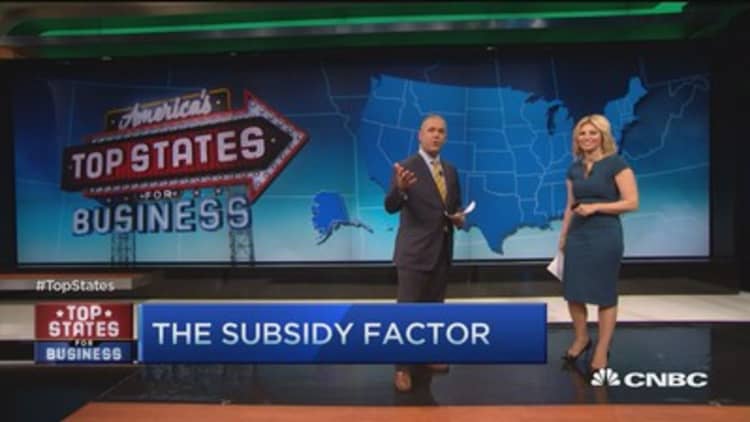
New York is a big state with a long history of doing things big. That is especially true when it comes to subsidizing business.
According to the watchdog group Good Jobs First, the Empire State has awarded nearly 72,000 subsidies to corporations, mostly since 2007, worth $22.6 billion. That is more than any other state and nearly twice the amount of its nearest competitor, Washington state.
New York is not shy about its generosity. The state's economic development arm, Empire State Development, lists as its mission the promotion of a "vigorous and growing" state economy "through the efficient use of loans, grants, tax credits, real estate development, marketing and other forms of assistance."
Read MoreAmerica's Top States for Business 2015: Our methodology
The "efficient" part is the subject of plenty of debate in New York and every other state. For now, it seems the subsidies—and the businesses that receive them—are winning.
"This is the dark side of the war among the states," said Good Jobs First Executive Director Greg LeRoy, who has been tracking the subsidies for more than 30 years. And he added that things are not getting any brighter.
While the number of deals sought by businesses began declining before the Great Recession and remains depressed, the assistance being offered by states is going up. The result, LeRoy said, is that a relatively small number of companies have increasing leverage, and "they're taking it to the bank."
That is especially evident when it comes to what Good Jobs First calls "megadeals," worth $75 million or more. Since 2008, the group said, the number of giant awards per year has more than doubled from the previous decade. They include the record $8.7 billion that Washington state awarded to Boeing in 2013.
[Subsidies are] the dark side of the war among the states.Greg LeRoyexecutive director of Good Jobs First
Are the subsidies making the states that award them any more competitive?
"Very marginally," said LeRoy noting that state and local taxes—which the majority of deals target—make up less than 2 percent of business costs.
Workers are the new weapon in the battle for business.
"Incentives rarely work or can rarely make a difference," he said. Even when they seem to be working, the effect is often short-lived.
Read MoreState House to the White House? How the governors stack up
In New York's case, the subsidy figures are so large because they include billions of dollars in free or discounted power from the state's utilities. The state agreed to provide $5.6 billion in electricity discounts over 30 years to Alcoa in exchange for a $600 million investment in one plant and an agreement to preserve at least 900 jobs at the facility. But New York found that, as is the case in many such agreements, this one was built on shifting sands.
After the company began laying off workers elsewhere as part of a nationwide cost-cutting plan last year, the state sweetened the pot with more electricity discounts, described at the time by Gov. Andrew Cuomo as a move to avoid layoffs.
"This agreement … applies firm job commitments that Alcoa must adhere to for its continued use of some of the lowest-cost electricity in the country," Cuomo said in a statement March 31, 2014. Alcoa has stayed put—for now.
The great debate heats up
LeRoy said it is no coincidence that some states that are most generous with subsidies are also facing budget issues. In New Jersey, Gov. Chris Christie has awarded more than $5 billion in subsidies—including half a dozen deals that were worth more than $200 million apiece. State officials have defended the incentives as a way to attract investment and save and create jobs. But this year, the state suffered its ninth credit downgrade since the governor took office.
Even states that have tried to back away from subsidies are finding it is not as simple as it may seem.
Soon after taking office in 2011, Michigan Gov. Rick Snyder called for an end to some of the state's most generous incentives.
"Let's stop the tax credits—and realize in many cases that the only reason they're in the tax code is because someone had more political power," he said that year.
Read MoreAn American workplace war that's reached a tipping point
But the state agreed to continue to honor credits it had previously granted, some dating back to 1995. The result: Four years after the credits ended, Michigan taxpayers are still on the hook for nearly $9.4 billion, state officials say.
Other states have been trying to move away from subsidies by pursuing what are known as "sector strategies"—a big buzz phrase these days in economic development circles.
The idea is to target a state's existing strengths, like a big concentration of health-care professionals, and build on that. Money that might be spent on incentives to lure a specific company might instead be spent on enhanced training programs and facilities to lure multiple companies to the region.
But while economic development professionals may be pushing the idea, LeRoy said, "They have to answer to elected officials who want to cut ribbons."
Because of that, and because businesses are happy to take any subsidies they can get, the war of incentives is unlikely to end anytime soon.






